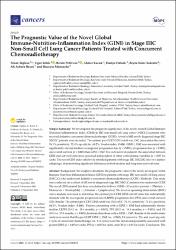The prognostic Vvalue of the novel global Immune-nutrition-inflammation index (GINI) in stage IIIC non-small cell lung cancer patients treated with concurrent chemoradiotherapy

Göster/
Erişim
info:eu-repo/semantics/openAccessTarih
2023Yazar
Topkan, ErkanSelek, Uğur
Pehlivan, Berrin
Kucuk, Ahmet
Öztürk, Duriye
Şirin Özdemir, Beyza
Besen, Ali Ayberk
Mertsoylu, Hüseyin
Üst veri
Tüm öğe kaydını gösterKünye
Topkan, E., Selek, U., Pehlivan, B., Kucuk, A., Ozturk, D., Ozdemir, B. S., ... & Mertsoylu, H. (2023). The Prognostic Value of the Novel Global Immune-Nutrition-Inflammation Index (GINI) in Stage IIIC Non-Small Cell Lung Cancer Patients Treated with Concurrent Chemoradiotherapy. Cancers, 15(18), 4512.Özet
Background: We sought to determine the prognostic value of the newly developed Global Immune-Nutrition-Inflammation Index (GINI) in patients with stage IIIC non-small cell lung cancer (NSCLC) who underwent definitive concurrent chemoradiotherapy (CCRT).
Methods: This study was conducted on a cohort of 802 newly diagnosed stage IIIC NSCLC patients who underwent CCRT. The novel GINI created first here was defined as follows: GINI = [C-reactive protein × Platelets × Monocytes × Neutrophils] ÷ [Albumin × Lymphocytes]. The receiver operating characteristic (ROC) curve analysis was used to determine the optimal pre-CCRT GINI cut-off value that substantially interacts with the locoregional progression-free (LRPFS), progression-free (PFS), and overall survival (OS).
Results: The optimal pre-CCRT GINI cutoff was 1562 (AUC: 76.1%; sensitivity: 72.4%; specificity: 68.2%; Youden index: 0.406). Patients presenting with a GINI ≥ 1562 had substantially shorter median LRPFS (13.3 vs. 18.4 months; p < 0.001), PFS (10.2 vs. 14.3 months; p < 0.001), and OS (19.1 vs. 37.8 months; p < 0.001) durations than those with a GINI < 1562. Results of the multivariate analysis revealed that the pre-CCRT GINI ≥ 1562 (vs. <1562), T4 tumor (vs. T3), and receiving only 1 cycle of concurrent chemotherapy (vs. 2-3 cycles) were the factors independently associated with poorer LRPS (p < 0.05 for each), PFS (p < 0.05 for each), and OS (p < 0.05 for each).
Conclusion: The newly developed GINI index efficiently divided the stage IIIC NSCLSC patients into two subgroups with substantially different median and long-term survival outcomes.















